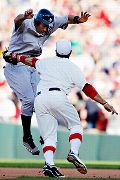Everyone knew the Red Sox and Yankees would be marking the 100th anniversary of Fenway Park on Friday by wearing 1912 throwbacks. What nobody knew, however -- maybe because it was a secret, or maybe just because nobody thought to ask -- was that the throwbacks would not have uniform numbers, which made this one of the strangest-looking MLB games in recent memory.  The thinking behind the numberless throwbacks was simple enough: Uniform numbers hadn't yet been invented in 1912. But teams have worn throwbacks from the numberless era before, and they've always added uni numbers to the throwbacks. (In fact, the Red Sox themselves have done it twice, as you can see here and here.) It's one of those modern compromises that is routinely made for throwback games, like wearing batting helmets even if the throwback design comes from the pre-helmet era. The thinking behind the numberless throwbacks was simple enough: Uniform numbers hadn't yet been invented in 1912. But teams have worn throwbacks from the numberless era before, and they've always added uni numbers to the throwbacks. (In fact, the Red Sox themselves have done it twice, as you can see here and here.) It's one of those modern compromises that is routinely made for throwback games, like wearing batting helmets even if the throwback design comes from the pre-helmet era.
But now that the Sox and Yanks have shown that it can be done, maybe we'll see more numberless throwback games in the future. The Yankees are often credited with being the first team to have worn uniform numbers, but that's incorrect. The first uni-numbered team was actually the Indians, who took the field wearing numbered jerseys on April 16, 1929. (The Yankees, whose first game had been rained out, debuted their numbers the following day.) By 1937, all MLB teams had added numbers to their home and road jerseys. Friday's BoSox-Yanks game was the first time since then that a team had gone numberless -- or, in this case, two teams. There have been three individual players who've worn numberless jerseys in the numbered era, however:  • On Sept. 4, 1961, pitcher Joe Horlen made his big league debut with the White Sox, who were playing in Minnesota that day. Horlen was a last-minute call-up for the game, and the Sox didn't have any numbered jerseys on hand, so he made his first major league appearance in a numberless jersey. (For the record, Horlen pitched four innings in relief that day and got the win.) • On Sept. 4, 1961, pitcher Joe Horlen made his big league debut with the White Sox, who were playing in Minnesota that day. Horlen was a last-minute call-up for the game, and the Sox didn't have any numbered jerseys on hand, so he made his first major league appearance in a numberless jersey. (For the record, Horlen pitched four innings in relief that day and got the win.)
• A similar situation took place on May 19, 1984, when Eric Davis made his big league debut for the Reds, who were playing in St. Louis. No numbered jerseys were available, so Davis was forced to go numberless. (He appeared as a pinch hitter and grounded out.) • The last game at Tiger Stadium took place on Sept. 27, 1999, and the Tigers marked the occasion by having the players in their starting lineup wear the uniform numbers of former Detroit greats. First baseman Frank Catalonotto, for example, wore number 5, for Hank Greenberg. In an inspired move, center fielder Gabe Kapler wore no number, to represent Ty Cobb, who had played in the numberless era. (As an aside, Tigers second baseman Lou Whitaker forgot to bring his jersey to the 1985 All-Star Game in Minnesota and was forced to wear a numberless replica jersey from the Metrodome gift shop. But he added the number in magic marker.) Interestingly, the numberless BoSox-Yanks game came only five days after Jackie Robinson Day, when every MLB player wore No. 42. That's sort of the same thing as going numberless, right? Everyone's wearing the same thing, you can't tell anyone by his number, the announcers occasionally get the players mixed up, and the game looks like it's taking place in an alternate universe. Some fans probably think unnumbered games and all-42 games are a little too weird, or too confusing, or maybe just stupid. But the feeling here at Uni Watch HQ is that these games are a good thing. For starters, they're fun, because they shake up the established way of doing things and remind us that uni numbers are a convenience, not a necessity. More importantly, in an ego-obsessed sports era, a numberless set of jerseys essentially makes all the players equal because they all look more or less the same. Like the coaches always say, there's no "I" in "team" -- and there's no number, either. Paul Lukas has several old flannel jerseys with no number on the back. If you liked this column, you'll probably like his daily Uni Watch web site, plus you can follow him on Twitter and Facebook. Want to learn about his Uni Watch Membership Program, be added to his mailing list so you'll always know when a new column has been posted, or just ask him a question? Contact him here. |
